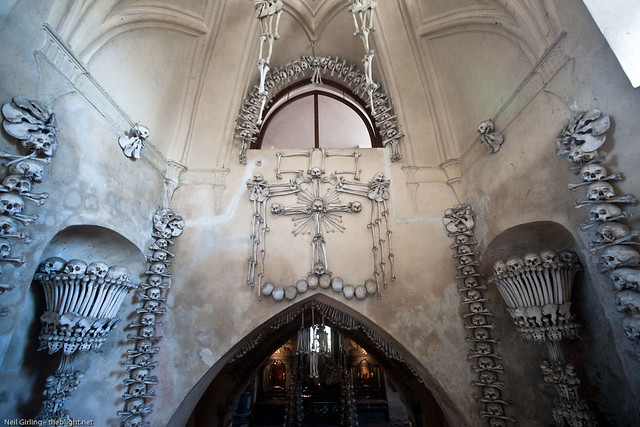 |
Photo by Sony of the
view outside of the Sedlec Ossuary.
|
The
Sedlec Ossuary is a chapel that is beneath a Catholic church called the
Cemetery Church of All Saints and is located in Kutna Hora, Czech Republic. It
is not just an ordinary chapel, though; it is a chapel decorated in human
bones. Sedlec became famous in the 13th century when an abbot came
from the holy city of Jerusalem and sprinkled some of its holy soil in the graveyard
of what was, at the time, a monastery that existed before the church (“The Cemetery”). As a result, many wealthy
people from around Central Europe desired to be buried in this cemetery. When
the plague struck Europe, demanding many graves, the bones of the deceased began to
overload the graveyard (“The Cemetery”).
When the church and chapel were built in the 1400s, many of the bones were
moved to the chapel beneath the church, becoming an ossuary for the town. When a
noble family, known as the Schwarzenbergs, purchased the church in 1870, they
hired a woodcarver, Frantisek Rint, to do something with the abandoned bones (Dunford, et al). He then used the 40,000 bones in the chapel to
create the masterpiece of the Sedlec Ossuary that sits in Kutna Hora today.
 |
| Photo from flickr of inside the Sedlec Ossuary. |
Also
referred to as the Church of Bones, the Sedlec Ossuary has many pieces of art
made from the human bones. There is a
chandelier located in the center of the church that contains at least one of
every bone in the human body (Lawson and Rufus). There are also pyramids of
bones located in each corner of the chapel, made of leg bones and skulls, and there
is a Schwarzenberg coat of arms, in honor of the Schwarzenberg family, that is
made of pelvises, finger bones, skulls, and arm bones. Other decorations
include “long streamers and festoons of ribs, vertebrae and tibias…a “fountain”
of ribs gushing from a hole in the top of a cranium, or a “bird” made of a
scapula and a hand” (Lawson and Rufus).
 |
| Schwarzenberg coat of arms and the chandelier
containing every bone in the human body (Zimmer). |
 |
Frantisek
Rint’s signature signed in bones inside Sedlec Ossuary with pyramid of bones in
background (Necromancer).
|
Works Cited:
Dunford,
Lisa, Brett Atkinson and Neil Wilson. “Sedlec Ossuary.” Czech & Slovak Republics. Lonely Planet, 1 Apr. 2007. Web. 16
Oct. 2012.
Johnson,
Kevin Orlin. “Relics.” Why Do Catholics
Do That? New York: Ballantine Books, 1994. 203-207. Print.
Lawson,
Kristan and Anneli Rufus. “Sedlec.” Weird
Europe: A Guide to Bizarre, Macabre, and Just Plain Weird Sights. Macmillan,
12 Jun. 1999. Web. 16 Oct. 2012.
mr.
nightshade. “Sedlec Ossuary (Kostnice) in Kutna Hora.” Photograph. flickr. Yahoo! Inc., 12 July 2010. Web.
26 Oct. 2012.
Necromancer.
“Sedlec Ossuary, chapel of the skeletons.” Photograph. Socialphy. 25 June 2012. Web. 26 Oct. 2012.
Sony.
“9. Sedlec Ossuary.” Photograph. Sony
Pngst. 6 Nov. 2010. Web. 26 Oct. 2012.
“The
Cemetery Church of All Saints with the Ossuary.” Kutna Hora Sedlec. 2012. Web. 26 Oct. 2012.
Zimmer,
Lori. “Sedlec Ossuary.” Photograph. Inhabitat.
Inhabitat.com, 29 Oct. 2011. Web. 26 Oct. 2012.
For further research:
“7
Wonders of the (Un)Dead World: Global Ossuaries”
Describes
seven ossuaries, including the Sedlec Ossuary, located throughout Europe.
“Articulating
Bones: An Epilogue”
Describes
the bone art in different ossuaries and how they portray death and its meaning.
A Walk in the
Ossuary in Sedlec
Contains
videos and photos involving the Sedlec Ossuary.
No comments:
Post a Comment